Jerusalem Postcard: Tears, Trinkets, Traffic
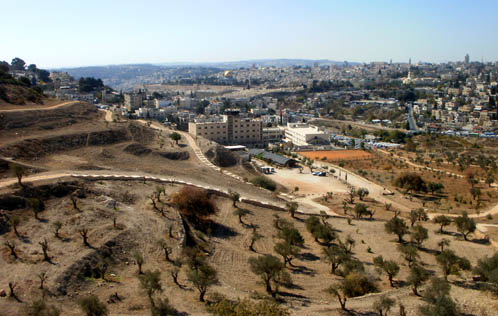
Mount of Olives
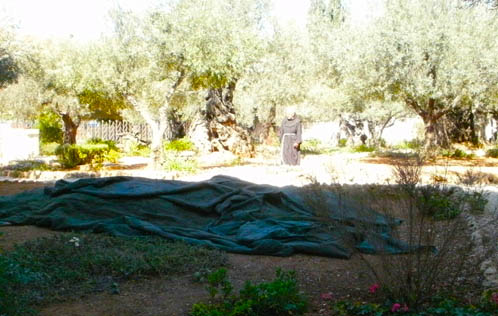
The Walled Garden of Gethsemane
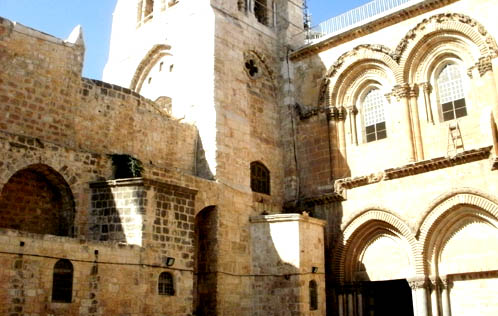
Church of the Holy Sepulchre
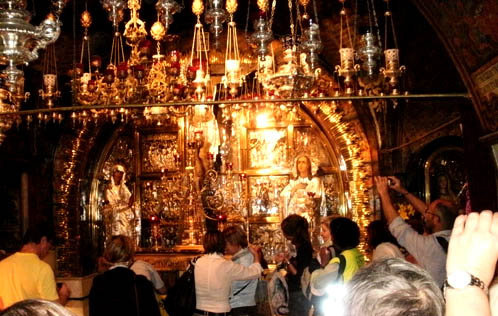
Church of the Holy Sepulchre
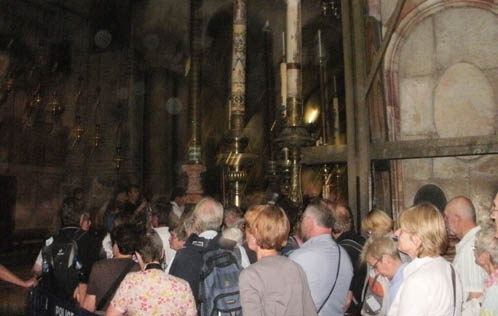
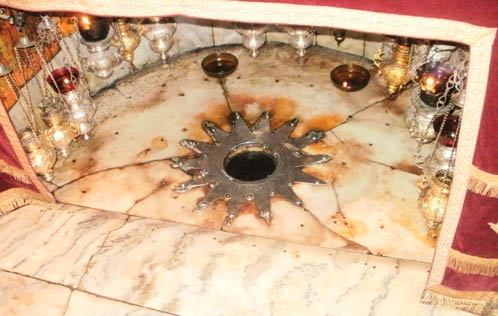
A silver star said to mark the birthplace of Jesus
“When we get off the bus, leave all your belongings behind. Only take a few dollars. Do not bring your passport or your credit cards. When we enter Jerusalem, you will be surrounded by people who will try to take your money. I know these people. If you want to shop, wait until we get to Bethlehem. We will go to an approved outlet where everything will be much cheaper than in Jerusalem. Why? They do not have purchase taxes in Bethlehem. Also you will be contributing to the Christian community there. They need your money.”
This was the message from our Israeli guide – a wiry, shaven-headed guy in his thirties with a mordant sense of humour and the appearance of a commando.
We were on our way to Jerusalem on an official tour sold by our cruise operator. There were forty-five of us, rolling out of Haifa on the coast road towards the Holy City. Our guide proudly briefed us on the top four industries in Israel: tourism, technology, defence and diamonds. The diamond industry began after the refugees from the holocaust arrived with the asset they could most easily hide about their persons. Defence – well, we all know about Uzi sub-machine guns and a host of other instruments of death originating from this neighbourhood. Technology – Microsoft, Facebook and Intel are heavily represented in Israel, and the country has a substantial home-grown IT industry. And the seven cruise liners docked in Haifa are compelling evidence of the strength of the tourist industry.
Whatever else you might say about Israel, it has a culture of invention, especially when compared with some of its well-endowed neighbours that rely on the expertise and intellectual property of foreigners.
Once we had received this homily on the local economy, we were allowed to enjoy the view in relative silence over the following hour, with the backdrop of an endlessly-repeating loop of fervent songs extolling the holy land. I think the assumption was that we were here as pilgrims, a description that certainly didn’t apply to me. I fell asleep, and woke as we approached the city through one of the well-appointed suburbs on the outskirts of the Old City.
The first stop was a photo-opportunity atop the Mount of Olives. We poured out of the bus to look down at a hill side that boasted a few rows of scratchy olive trees. Some of them, our guide told us, were more than two centuries old. Beyond the hill stood the limestone walls of the Old City, with the golden Dome of the Rock shimmering in the mid-morning sun.
After photos, we descended to the Garden of Gethsemane, where we met our first street sellers, offering beads, trinkets, water and postcards. As instructed we ignored them, even though I didn’t get the impression that we were about to mobbed by voracious pickpockets. Inside the walled Garden, we wandered past an unremarkable church, to a small fenced enclosure circled by a few ancient olives and patrolled by a fierce-looking monk who reminded me of one of slightly unhinged characters you encounter on a bus from time to time – make eye contact and you’re doomed to an impassioned tirade about aliens.
The whole area was choked with visitors, each led like sheep by the guide holding up a badminton racket converted into a numbered sign. The odd party of holy rollers would occasionally launch into a chorus of hallelujahs and similar devout utterings, while our party struggled to keep up with the raised racket. I couldn’t wait to get out of there.
So onwards through the gate to the Old City, past the Mount of Olives Cemetery where that devout media mogul, fraudster and man of principle Robert Maxwell is buried, past a drum-banging, marching Bar Mitzvah party to the Western Wall, also known as the Wailing Wall. To the right was the leaden dome of the Al-Aqsa Mosque, to which our guide scarcely alluded. Shame – I would have liked to have visited the Muslim shrines, but for some reason they were not on the itinerary of any of the tours offered by the cruise operator.
The massive slabs of the Western wall, the last remnants of Herod’s temple at the base of Temple Mount, sit in front of a large square. On the day we visited it was fairly empty, but the wall itself was lined with the devout, and inserting their little pieces of paper bearing their prayers into the cracks. It is divided into two sections, one for women, and twice the length for men. Was it to stop the women from being harassed, or because of some misogynistic ordinance? I shouldn’t have been surprised. After all, mosques (except the Grand Mosque of Makkah) and Orthodox churches have traditionally separated the worshipping women.
I went down to the wall. Men were standing silently with their hands on the stones. To the right, in a roofed area, orthodox Hassidim in their funereal black suits and hats were sitting reading the scriptures or incanting while nodding their heads as their ritual demands. One man was swaying next to the wall, weeping and moaning. Lamenting the loss of the temple two thousand years ago. I felt like an intruder, and quickly moved back to the square.
Impressive and atmospheric as the wall and its rituals are, I was not uplifted by the experience. Not because I am clearly not among the chosen, but because I was among people who believe they are. And because religious exceptionalism, together with its political manifestation, is deep in the soul of this city, the cause of centuries of conflict that continues today.
From there we moved down the Via Dolorosa, the route Jesus is supposed to have taken on his way to his crucifixion. We passed through narrow alleys of shops, through the Jewish , the Muslim and finally the Armenian quarters. They all looked much the same. Storekeepers looked resignedly as we passed by, knowing that the cruise parties has been warned against trading with them. I went into one of several selling ancient coins. Long enough to discover that I would have paid ten times the asking price for items I could have bought in the UK. No doubt that would have been only the beginning of the conversation, but negotiation takes time, and meanwhile the man with the badminton racket was moving us on to the next station of the cross – one of a series of locations where Jesus is held to have stopped on his journey.
I love souks, and I could happily have spent hours in the shops lining the Via Dolorosa, but it was not to be. We were moving towards the Church of the Holy Sepulchre. The church sits not on some impressive hill, but as one of a number of tall buildings accessible through winding alleys. There is a small square in front of it, which was packed with the faithful queuing to get inside. The interior is dark and gloomy. What little light gets in comes from grimy windows and from the top of the dome that covers the alleged site of the tomb. For centuries the Catholic, Orthodox, Coptic and Armenian churches have vied with each other for the guardianship of the church, and for their little piece of the building, often coming to blows, and neglecting the maintenance of the building because of disputes over responsibility. Exceptionalism at work again.
The church was packed with babbling groups of tourists. We went upstairs to the claimed site of the crucifixion. How three crosses could have been erected in such a small area, and why people believe that this was the site when biblical references claim that it happened outside the city walls is a testament to credulity, as is the tradition that his tomb lay but a few yards from the site of the cross. It is as if the builders of the first church decided to create a theme park whose attractions then became real. And real it seemed to many of the visitors, who knelt to kiss the marble slab covering the site of the anointment of Christ’s body, even though the slab is freely acknowledged to be a later addition.
Perhaps I missed the point. There is now way of knowing whether these sites are authentic, just as the various church-covered rocks in Galilee where Jesus is supposed to have stood are the result of tradition, and can never be otherwise. Jesus’s ministry only acquired significance many years after the events described in the scriptures. His crucifixion was a fairly routine event in a first-century land of zealots, robbers and religious mystics. So does it matter where the events actually occurred? Centuries of veneration of the so-called holy places have given them an atmosphere of their own – a holy aura in the minds of the faithful. And plenty of opportunities for commercial exploitation.
In the end, I suppose what matters is what you believe, and in those terms, one rock is as good as another. For believers, faith is surely everywhere.
So that was Jerusalem. There were many places I would like to have seen. This was just a sampler, if you like. The city is an archaeological treasure trove. Layer upon layer of habitation and destruction. Remnants of custom, culture and conquest. Centre of faith, hopes and dreams. Site of battles past and probably future. Perhaps even of the ultimate battle at the end of days if you happen to be of that persuasion.
Fascinating as it is, I still believe that this blood-soaked region would have been a happier place if the Emperor Hadrian had left Jerusalem alone, and not built his colony among the ruins in the second century. But memories were long, and no doubt if Jerusalem no longer existed someone else would had to have invented it in due course.
We trooped out through the Jaffa Gate, to a quick lunch and back on the coach for Bethlehem, the birthplace of Jesus. Bethlehem lies within the area controlled by the Palestinian authority, so we needed to pass through the border and acquire a new guide. The border checkpoint was a narrow gap in the notorious concrete wall that divides today’s Palestine and Israel. Israel’s way of curbing armed incursions, suicide bombers and intifada mongers. An ugly concrete thing several meters high that runs through borders disputed by Palestinians, dividing families, property and businesses. On the Palestinian side of the wall, the ubiquitous graffiti – pictures of Yasser Arafat, slogans and cartoons depicting the plight of the enclosed.
Bethlehem is one of the few Palestinian towns with a sizeable population of Christian Arabs. Its poverty compared with Jerusalem and Haifa is immediately apparent. Crumbling buildings and ancient cars. From the bus station we headed to the Church of the Nativity. Like the Church of the Holy Sepulchre in Jerusalem this is an ancient shrine. The first church on the site was built at the behest of Helena, mother of the Roman emperor Constantine in the fourth century, and rebuilt by the Eastern emperor Justinian – the builder of the magnificent Ayia Sofia in Istanbul – in the sixth century. As in Jerusalem, there are clear demarcation lines between the Orthodox, Armenian and Catholic faiths. The adjoining Catholic church is a relatively new addition. The old church is under the sway of the Orthodox priests.
Also as in Jerusalem, maintenance of the church has for centuries been neglected because of turf wars between the custodians. But it is an imposing interior with fine floor mosaics, far less cluttered than the Holy Sepulchre. As our guide tried to give us a commentary on the building and its origins, he struggled to be heard over the voices of many other guides doing the same thing. The babble quietened down whenever the security guard barked “silence!” and then rose again.
Behind the glittering altar, where Orthodox priests stood swapping liturgical responses, is a tiny grotto, said to be the stable where Mary gave birth to Jesus. On that spot is a silver stars that the faithful kneeled over to touch or kiss. A few yards away, a niche in the rock where Mary swaddled the infant.
Again, a place of great meaning to those who believe in its provenance. And whatever its origins, an experience to stand in a place of continuous worship for eighteen centuries – in the footsteps of the Persian invaders who spared the church because the depicted on the wall were in Persian dress, the Umayyad caliphs, the Crusaders, the Ottomans and the monastic orders that clung doggedly to their church over centuries.
And finally came the inevitable shopping opportunity. We were driven to the “authorised outlet” a mile or so from the church. There we were shown nativity scenes carved with olive wood, jewellery, icons, key rings, cheap bracelets and necklaces and souvenir mugs, not to mention the gift packs containing little bottles of holy water, olive oil, frankincense and the earth of the Holy Land. Just the sort of thing to bring home for those not fortunate enough to make the trip.
The place is owned by a consortium of Christian Arab merchandisers. No doubt the faithful felt some obligation to support the businesses of the Christian minority, because business was brisk.
A good hour passed before the next coach tour arrived, and then it was back in the bus for the long hike back to Haifa. The trip took a good three hours – the ship was originally scheduled to dock in Ashdod, which is much closer to Jerusalem. But Israel’s decision to launch a missile raid on members of the Islamic Jihad group in Gaza led to fears that Ashdod might come in for a few retaliatory rocket attacks.
So we crawled back through the checkpoint and down the motorway, sharing a stop-off with a coachload of soldiers brandishing their heavy machine guns as they sipped their cappuccinos. Back in the coach, the CD of patriotic songs was back on its endless loop. At the port, our guide gave us a farewell exhortation to tell all our friends what a wonderful country Israel is, and to come again soon.
In some ways he has a point. Israel has an impressive infrastructure. It is far from the haven of fanatics it is made out to be. Its people have brains, energy and determination.
And yet at what cost? Will the pressure of having few friends in the region, the aggression born of a constant sense of external threat, the legacy of dispossessions brought about by its birth, and the disproportionate influence of the religious over the secular finally lead to the dissolution of the Jewish state – an outcome many of my Arab friends believe in and fervently pray for? Not without collateral damage on a biblical scale, I suspect.
At last, back to the ship. So farewell “plucky little Israel” – home of the kibbutz, irrigators of the land, scion of Nobel Prize winners, avenging angels, demolishers of homes, expropriators of land and moderators of a dozen squabbling faiths and sects. And human beings like the rest of us.



6 Responses to Jerusalem Postcard: Tears, Trinkets, Traffic
You must be logged in to post a comment Login